Southern Calamari may well be a year round fishery in Port Phillip Bay and Western Port, but even when they are in abundance some anglers still find catching them a challenge.
Why is calamari so hard to catch? What are the secrets? What am I doing wrong? These are just some questions that go unanswered. In this Back to Basics feature, I will try to unravel some of the mysteries surrounding calamari that may give you a better chance on your next squidding adventure.
Calamari love to hide and stalk their prey. Weed beds, reef structures and piers all attract baitfish, crabs or other morsels worth devouring if you’re a calamari. With this in mind, practically every inshore reef, pier or jetty and weed bed harbour plenty of calamari. During some months, these weird and wonderful critters are so plentiful they can be in there tens of thousands.
Calamari live for approximately 12 months, during that time they are programmed to eat, breed and then die, not much of a life really.
When searching for likely areas, pay attention to local fishing reports. Once you hear they are on the go then head to and fish the same locations. Alternatively working shallow weed beds in 2-5m of water or rocky headlands are likely locations to find calamari.
For those specifically looking for locations try Oliver’s Hill at Frankston, Black Rock, Red Rocks and Fisherman’s Beach at Mornington, hard up against Mt Martha Cliffs, the weed beds at Rye, amongst the boat moorings at Sorrento, Pt Franklin, and Queenscliff and from any of the piers or jetties around these locations. For those fishing in Western Port, the middle spit, Quail and Tyabb Banks, Cleeland Bight, Stony Point Pier, Reef Island, Mchaffies Reef, Cat Bay and Flinders areas are all worthy.
In Tasmania any part of the coastline on the east coast is worth a flick, especially around St Helens and Coles Bay. The Tamar River usually has plenty of calamari around Kelso. Bear in mind the closed season in Tasmania – see the fact box for more details.
One thing with calamari is they are very temperamental in their feeding patterns. For instance the slightest thing can put them off, in particular water clarity. If there has been a blow and the water is silted up, you will find it very difficult to find them in numbers.
Being a nocturnal hunter they are also more active during the night and at dawn or dusk. I generally concentrate my session during first light in calm conditions. Often tide fluctuation will also dictate whether they will feed or not and where they are for that matter. I have found during the run-out tide and low tides they are more likely to be in 5m of water should there be weed or reef nearby.
On the high tide or run-in tide, I fish shallower up to 2m of water and have found them in good numbers. I guess as the tide moves in, so do the baitfish, hence the calamari follow the food source.
Although you can fish for calamari with any rod or reel, more specifically designed lure flicking rods are recommended.
Many anglers do use their whiting rods or light fibreglass bait fishing rods, don’t get me wrong they will catch calamari but aren’t as effective as graphite lure casting rods. Fibreglass rods are too light in the tip which when working a squid jig is almost like a spring effect. This doesn’t get the jig moving and acting correctly in the water, often deterring calamari rather than enticing them.
Graphite rods on the other hand are a much faster taper allowing the jig to be worked with more control. This control allows the angler to manoeuvre the jig how and where they want. More so for an erratic action which calamari can’t resist.
There are many inexpensive and expensive rods on the market ideal for calamari fishing, they can also double as your soft plastic fishing rod. For those not wanting to empty the ATM there are still plenty of options available. Whatever you do purchase make sure you have a well-balanced outfit.
I have been using a Wilson Blade ‘n’ Tails light model rod for the past few years and found it to be light in the hand and a perfect match up to the 2500 series reel I have on it. It is an extra fast tapered rod allowing me to feel the slightest of hits on the jig. This instant feel situation enables me a quicker strike action, so the minute I feel them grab the jig I can set the hooks.
The reel is spooled with 4lb braid enabling further casing distance from lighter jigs. The braid also allows me better movement control of the jig. Mono lines only mask the action due to its stretch and it can feel as though you’re jigging with elastic, limiting the lures action.
Light leaders are also recommended, you don’t have to go too heavy but you are working around structure, 4lb or 6lb strengths are adequate and I suggest using fluorocarbon for its invisible and abrasiveness characteristics.
Calamari are quite shy, especially when hunting or the sun is bright. They tend to glide around their victim looking for a direction to attack. More often than not they attach from the back where the victim can’t see them but on occasions they will attack from the head. A calamari will stalk its prey by hiding out of sight until the animal is within range, then shoots out its arms to ensnare the food.
When fishing for calamari with lures, the technique involves working the lure to imitate a prawn or baitfish. This is by lifting and flicking the rod tip vigorously so the lure jerks and moves quickly in the water before pausing for a short period and then repeating the process.
It is generally when the jig is paused and slowly sinking that a calamari will lunge and grab the jig becoming hooked. Often you go to work the jig again and find as you lift the rod tip a calamari is on the end of the lure.
On different days you will find different retrieve methods will work, it is up to you to figure out what will trigger them to strike.
Bait fishing is also an effective fishing technique for both land-based and boat anglers. From piers or rock ledges the same technique can be used. A handline is the most widely used method when a squid float is attached above a squid prong containing a silver whiting or pilchard.
This can be thrown out and left to sit in the current. Ideally the baited jig should be set about 1m from the weed bed or reef, so a little research into the area being fished wouldn’t go astray.
Boat anglers can also use this technique, particularly when fishing in Western Port. The baited jig approach seems to attract the larger calamari and works effectively when in conjunction with a light berley trail of mashed pilchards. If fishing in Western Port or any tidal areas, two hours either side of the tide is recommended enabling the jigs to sit near the sea floor.
Alternatively, you can use the same set-up, but instead attach it to a surf rod. This will allow a further cast of the jig should you be fishing from a rock ledge or pier. I particularly use this method when fishing from Flinders Pier or Cleeland Bight where I do most of my land-based calamari fishing.
Is there a jig that will out fish all others? I dare not say. However, there are jigs that will outperform others on different days and a lot of that is to do with colour, size and sink rate.
Different manufactures make different jigs and at the end of the day, a jig isn’t just a jig. I have said this on many occasions but cheaper jigs just don’t cut it these days. Calamari are have become too smart!
Although there are $30 jigs on the market, the $15 jigs are very good and will work a treat. For me, Yo-Zuri jigs are still number one and continue to perform very well considering they have been making jigs since before I was born.
My collection consists of a wide range of sizes although the 2.0 and 2.5 sizes are the most effective. I have a wide range of colours in which the more natural colours tend to work better for me these days. Ask me 10 years ago and I would have said you only needed pink; how times change. A newbie but a goody is assorted sink rate jigs. The slower sinking jigs that sink around 1m over 7 seconds are going to stay in the strike zone longer producing more strikes; I have found these to be dynamite.
In the world of calamari fishing you can take it from just a day on the water to a full-blown assault on these eight-armed freaks of the ocean.
I am still enthralled by this species and find it hard to avoid them. Calamari are great fun to catch for the whole family providing entertainment and a tasty meal at the end of the day.
If you haven’t caught calamari before, grab some jigs and go reef exploring.
TEXT BOX 1.
CALAMARI BAG LIMIT
The limit of calamari an angler can catch in Victorian waters is 10 per person per day. No size limit applies.
In Tasmania a possession limit of 15 applies, which includes possession in the home.
TEXT BOX 2.
JARROD’S CALAMARI RECIEPE
Cut 500g of freshly caught calamari into 1cm thick rings.
Heat frypan and melt a tablespoon of butter.
Add calamari, a heaped teaspoon of garlic and a generous pinch of chilli flakes.
Fry for 2 minutes on high constantly stirring.
Place on plate, serve with chips and eat with tartar sauce.
Enjoy!
Facts
Tasmanian Closed Season
Areas on Tasmania’s east coast are closed seasonally to protect spawning southern calamari when they are most vulnerable.
In general the closure will be from early October to mid December, but anglers should contact the DPIW to confirm arrangements. Dates for 2009 are yet to be released. Check www.dpiw.tas.gov.au for up to date information.
The closure in the past had applied to all waters south from Lemon Rock (south of Wineglass Bay) to the northern end of Marion Beach (south of Maria Island) and includes Coles Bay, Great Oyster Bay and Mercury Passage.
During the closure period, taking and possessing calamari and any other squid is prohibited in this area.
For more information contact:
Recreational Sea Fishing Information Line on (03) 6233 7042;
Commercial Scalefish Section on (03) 6233 6717; or
DPIW switchboard statewide: 1300 368 550 (local call).
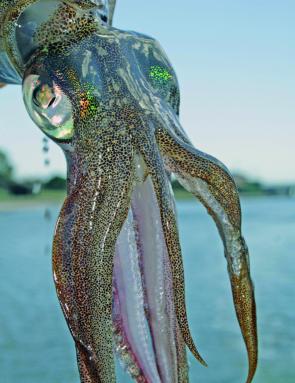
Up close and personal, the business end of a southern calamari!

A good selection of jigs can let you match the hatch should you need to.
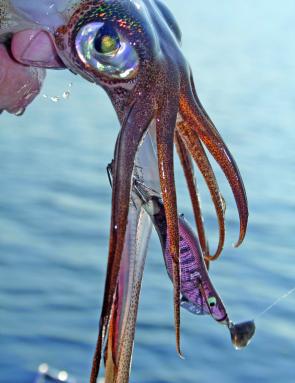
Don’t be afraid to use smaller jigs, often larger calamari will prefer smaller size baits.
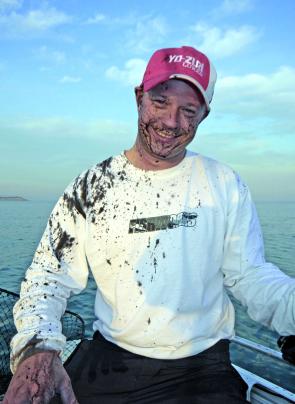
Did I say, mind the ink!
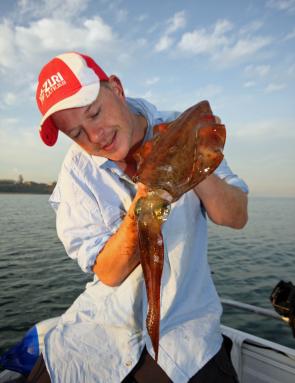
That’s a meal in itself.
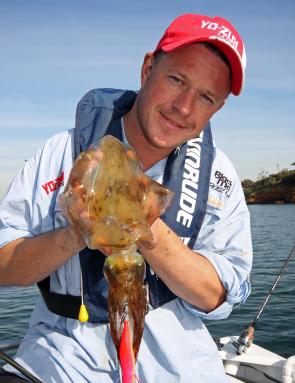
Although natural coloured jigs work well, sometimes you just have to toss out a pink.




